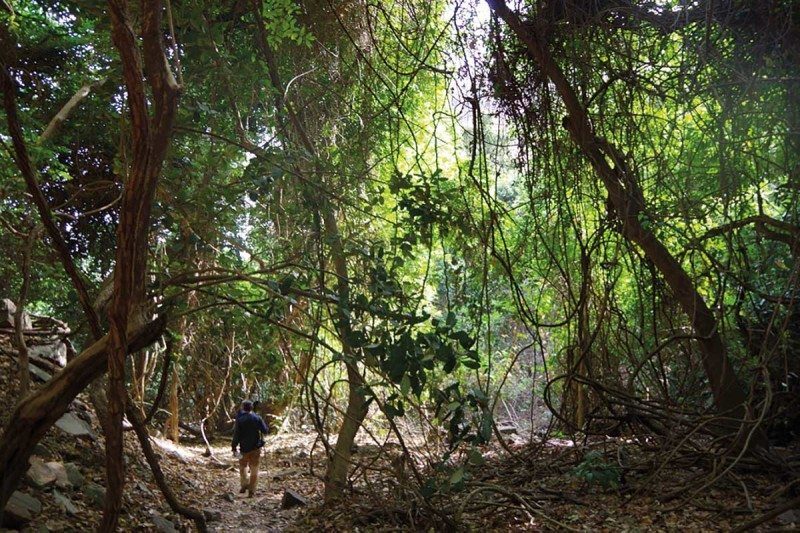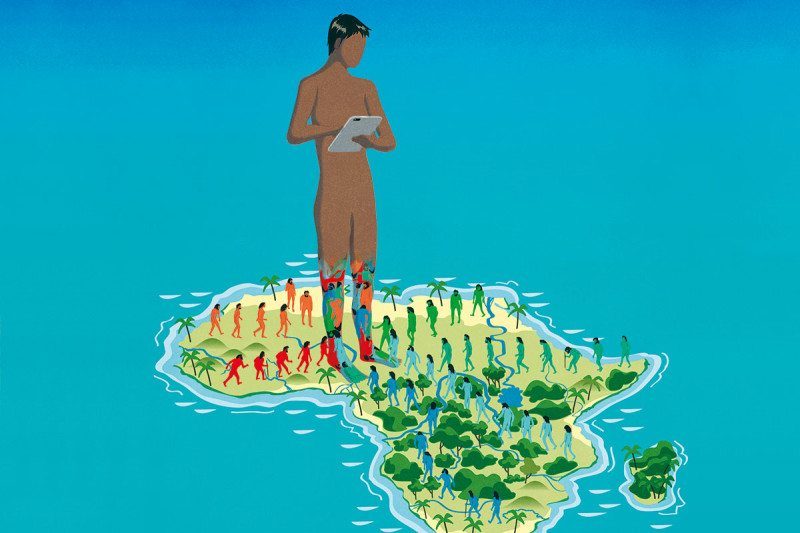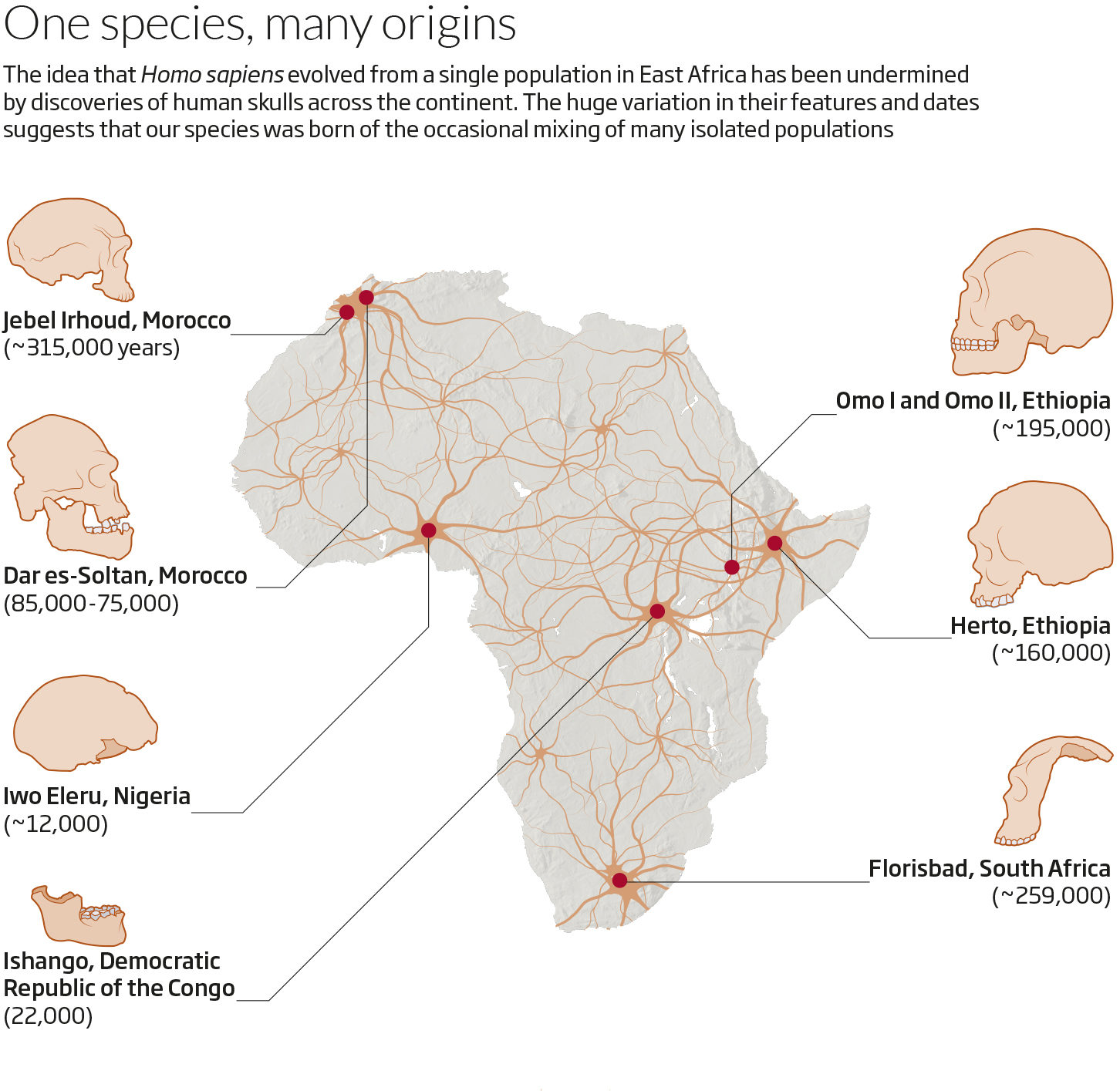In fact, if you were to travel back to the very beginnings of our species and select a random group of humans, they would look unlike anyone living today in Africa or elsewhere. What's more, they would show extraordinary physical variation - greatly exceeding that in modern human populations. Far from becoming more diverse as we have adapted to life in different parts of the planet, Homo sapiens is more homogeneous today than our ancestors were.
This is a real puzzle. It simply doesn't fit with the long-held idea that we arose from a single population in a corner of East Africa. In fact, mounting evidence from fossils, archaeological remains and genetic analysis points in a new direction. Now researchers, including myself, are trying to work out what it all means: why our African forebears were so physically different from each other, and how our species lost the huge variety it once had.
The textbook story of our origins has seemingly solid foundations. In the late 1980s and early 1990s, it became possible to sequence the DNA in mitochondria. These tiny structures, which power our cells, are inherited solely from our mothers. So, by comparing the genetic variation in people living today, it was possible to track back to the common female ancestor of us all. Sometimes referred to as "Mitochondrial Eve", although not necessarily a single person, she lived in Africa between 150,000 and 200,000 years ago, geneticists calculated. Shortly after this revelation, human fossil remains from two Ethiopian sites were dated to 195,000 and 160,000 years ago, placing our earliest ancestors in East Africa.
It was a neat picture. Furthermore, it seemed to solve a controversy surrounding what the first people looked like. Humans alive today have a characteristic skull shape, including a rounded braincase, a smooth, high forehead, a small face and a prominent chin. However, these features don't appear all together in any early member of our species. Instead, we see a wide variety of skulls that exhibit different mixes of modern features alongside archaic ones, such as large, robust faces, pronounced brow ridges and elongated braincases. This fuelled disagreements about which constellation of features should be used to distinguish early members of our species from now-extinct hominins. The mitochondrial research provided a solution: any fossil older than 200,000 years must be another species.
This still left the problem of trying to reconcile the objects our ancestors made and used with the picture drawn from fossils and genes. For about 1 million years, hominins shaped rocks into hand-held axes and other large cutting tools, such as picks and cleavers. Then, there was a shift towards far more sophisticated techniques. This technology, known as the Middle Stone Age, focused on the chipped stone flakes that came off rocks, rather than the rocks themselves. These flakes were shaped and mounted onto wooden shafts in complex ways, often using glues and bindings manufactured according to specific recipes. The ability to create and combine items that don't occur together in nature in anticipation of a range of diverse tasks has long been seen as a reflection of advanced cognition. It is considered a hallmark of our species. But here's the thing: abundant evidence makes it increasingly clear that the Middle Stone Age didn't emerge in one location at the purported dawn of humanity. Instead, there was a wholesale, continent-wide shift to this new technology around 300,000 years ago.
Other challenges to the dominant view of our origins have emerged in recent years. These include fossils found at Ishango in the Democratic Republic of the Congo, which, although dated to just 22,000 years ago, have decidedly robust, archaic features. Then there's a skull with an odd, elongated braincase found in southern Nigeria. It is around 12,000 years old, yet looks more like fossils dating from 100,000 to 300,000 years ago than people living today. Some of these fossils had even previously been discounted as being early examples of H. sapiens.
Compounding these biological anomalies, in 2014, I uncovered Middle Stone Age tools in the far west of Africa dating to the same late time period. When most other African populations had progressed to making diminutive stone tools known as microliths for tasks as diverse as tattooing and producing multi-component weapons, this group had retained the technology associated with the earliest H. sapiens.
There are two possible explanations. Perhaps other hominin species were living in Africa alongside us for far longer than anyone imagined. Alternatively, these strange-looking beings were humans, raising the possibility that some pre-200,000-year-old fossils with equally bizarre looks might also belong to our species. The idea that we should cast our net more widely when fishing for early humans gains support from another quarter. Advances in genetic analysis have revealed the first glimmerings of an older origin for H. sapiens, with the discovery that we and our sister species, the Neanderthals, shared a last common ancestor about half a million years ago. Such developments have led some to question the classification of a diverse array of early fossils from across Africa.
Then, last year, came the discovery of new early H. sapiens fossils. They didn't come from East Africa, nor were they less than 200,000 years old. Instead, they dated to a staggering 315,000 years ago and were found in the far north-west of the continent, in Morocco. "This find changes everything," says Philipp Gunz of the Max Planck Institute for Evolutionary Anthropology in Leipzig, Germany, who analysed the fossils. "These early individuals had modern faces and modern teeth, but elongated braincases. This suggests that features of brain shape, and perhaps even brain function, emerged within our species."
Comment: And fossils found much further afield and of a much older date debunk the Out of Africa hypothesis: Skull unearthed in China could re-write our understanding of the 'out of Africa' theory of human evolution
Taken with the other evidence, this anthropological bombshell has persuaded a group of 23 researchers - including Chris Stringer of the Natural History Museum in London, Mark Thomas of University College London, Lounès Chikhi of the French National Centre for Scientific Research in Toulouse and me - that we need to radically rethink how our species emerged. In an upcoming paper, we suggest that a diverse array of H. sapiens populations, displaying a mosaic of archaic and modern features, lived over an extensive geographic area from Morocco to South Africa between about 300,000 and 12,000 years ago.
How could such widely dispersed and physically diverse populations all belong to a single species? One way to conceive of this is to imagine the human lineage as a river. Although there is only one river/species, as time passes, different channels branch off and rejoin it. Just as the river's braids are separated by islands that form and are submerged, so environmental barriers kept our ancestors apart, and adapting to different conditions. This fits with emerging evidence of asynchronous changes in climate across different regions of Africa as our species began to appear. For example, the Sahara repeatedly greened for short periods every 100,000 years or so, while equatorial Africa underwent extended periods of drought. These and other similar processes across the continent would have created fluctuating barriers, shifting human populations around and modulating their degrees of isolation. Moreover, studies of other African mammals indicate that such conditions explain much of the physical diversity found within a species.
Stringer has called this new perspective "African multiregionalism". East Africa is still important in human evolution. However, the origins story featuring a single, small population in the savannah is out. Instead, a messy beginning involving multiple populations, regions and environments is in. Although this scenario is more complex, it reconciles the genetic, fossil and archaeological evidence. It also explains the early, pan-African emergence of the Middle Stone Age as an outcome of becoming human.
Indeed, the oldest hints of this sophisticated technology may date to around half a million years ago, which coincides with the split between our ancestors and those of Neanderthals, reinforcing the idea that our species might have originated even as early as that. Subsequently, populations repeatedly came into contact with one another over timescales of around 100,000 years, exchanging genes and ideas. In this way, the process of morphological and behavioural modernisation eventually took place across the entire African continent.
The archaeological record also reveals how these modern brains began to create a variety of technologies in different regions of Africa. An incredible flowering of material culture - featuring some of the earliest examples of art and ornamentation - occurred at the extreme ends of Africa between 130,000 and 60,000 years ago, when the central regions separating them were much less habitable. The objects from southern and northern Africa show early signs of sophistication and are comparable in their complexity. However, they are so utterly different from each other and anything seen elsewhere, they suggest that the populations who made them had been isolated for a long time. Zooming in on North Africa, I found that groups of people living in regions separated by ecological barriers such as deserts or rivers showed variations in their material culture. In other words, they appear to have remained relatively isolated from one another.
If African multiregionalism is correct, it has big implications for genetic analysis too. "The diversity of early African populations and their specific patterns of mixing and separation are critical for how genetic data are interpreted and, ultimately, how the early prehistory of our species is reconstructed," says Chikhi. Studies have generally assumed that early H. sapiens exchanged genes in a random fashion, at a constant rate over time. African multiregionalism suggests otherwise. This would mean that the textbook view of humans originating in a single, small population is based on a misinterpretation. "There is no unambiguous genetic evidence for it," says Chikhi. The same goes for the idea that humans evolved in East Africa. "Genetic data alone do not support any single region of Africa over any other," he adds.
Fruitful liaisons
While interpretation of the genetic evidence may be less watertight than once thought, genetics still offers a unique window on our past. In particular, it might help resolve the hot question of whether our early forebears interbred with now-extinct hominin species in Africa. They certainly shared the continent with some, including the recently discovered Homo naledi, which inhabited southern Africa 250,000 years ago. Interbreeding with the primitive-looking H. naledi seems highly unlikely, but whether it happened with other species is another matter. We know there were liaisons much later, outside Africa, with Neanderthals and Denisovans, and genetic studies have identified very ancient branches in the human tree, which look like evidence that hybridisation happened in Africa too.
Vast swathes of Africa remain unexplored for clues about our beginnings and may yet yield the crucial pieces of the human origins puzzle. In particular, discoveries documenting early human habitation in Asia's rainforests indicate that we ignore environments such as forests at our peril. Our species might have exchanged genes with late surviving hominins hiding out in forests. Adaptations to different habitats may also have kept human populations apart in Africa. Such scenarios would help explain why early humans exhibit such a profusion of forms. We see this mix of ancient and modern features in fossils and in objects people created right up until 12,000 years ago. Then it vanishes. What happened?
Fossil hunters have yet to explore much of Africa, especially forests and deserts (above and below)

We know that 12,000 years ago marks the beginning of a revolution for humanity. This is when Earth's climate entered a warm and unusually stable period known as the Holocene, which persists to this day. It seems likely that people have always tried to control and alter their environment, but with climatic stability such experiments were finally able to take off. Farming was born. And this had big implications for human evolution.
For a start, it shaped our genome. "The intense genetic selection precipitated by agriculture is like nothing seen before," says Thomas. "Lactase persistence - the ability to digest the main sugar in milk as adults - evolved rapidly during this time, giving a huge advantage to dairying populations over hunter-gatherers." Farmers are also much better equipped than hunter-gatherers to weather a range of environmental threats through agriculture itself. As a result of these genetic and cultural adaptations, farming populations grew and migrated into new areas so that over the next few thousand years, most people were living this way. The homogenising effect on humanity was so pronounced that anthropologist Marta MirazÓn Lahr at the University of Cambridge has dubbed it the "Holocene filter".
Yet the truly astonishing revelation is that we were so diverse in the first place. As this new narrative is fleshed out, there are bound to be more surprises. Who knows what treasures lie in Africa's forests and in its central and western regions? My studies and those of other colleagues have only scratched the surface. The secrets locked up in DNA could be just as revelatory. No early member of our species has yet had its DNA sequenced because heat and humidity, common in Africa, degrade ancient DNA. But with improvements in genetic analysis it is surely only a matter of time. Somewhere, perhaps in a deep, cool cave, lies a fossil containing the blueprint of an ancient H. sapiens. Decoding it will open a whole new chapter in the rapidly evolving story of our origins.






Comment: See Also: